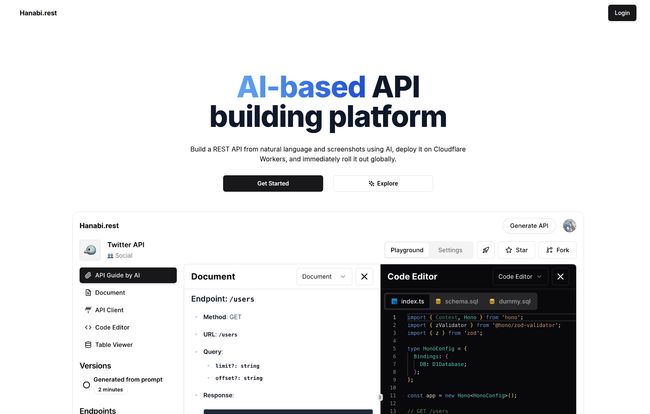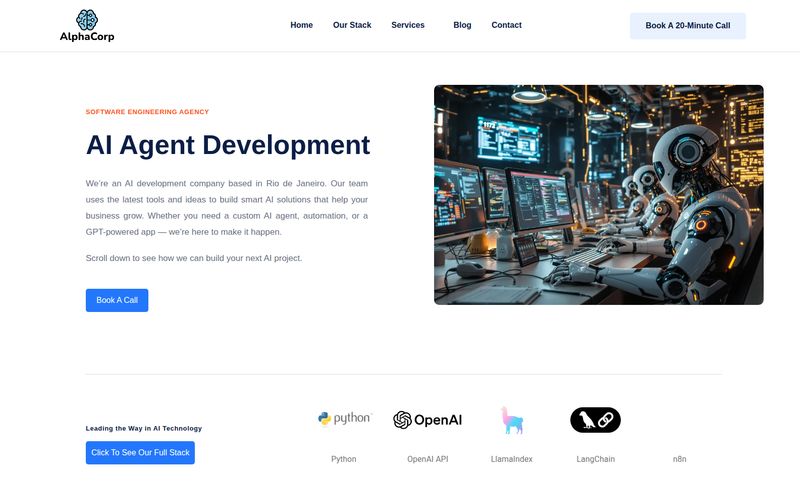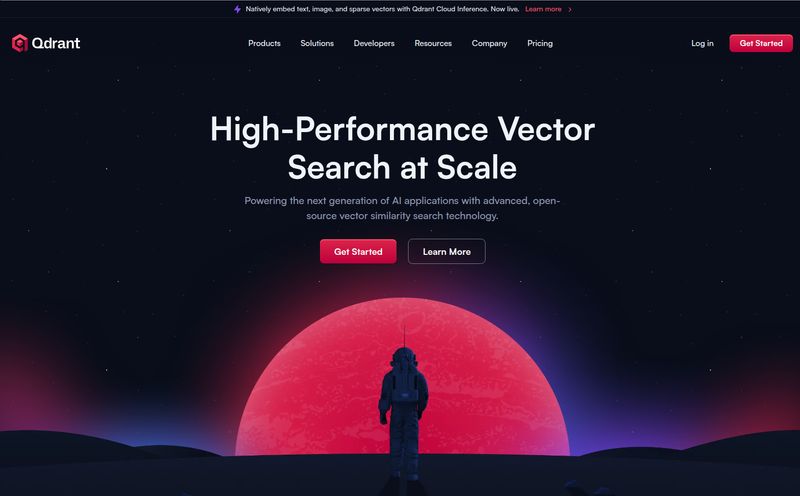For years, I've been deep in the trenches of SEO, traffic, and the tech that powers it all. And a huge part of that tech is the humble API. Building them can be a slog. You know the drill: setting up the server, defining the routes, writing the controller logic, dealing with boilerplate... it's repetitive work that stands between you and the actual fun stuff.
So, when a tool like Hanabi.rest pops onto my radar, claiming it can build and deploy REST APIs from natural language and even screenshots, my inner skeptic raises a well-trained eyebrow. Is this another overhyped AI toy, or is it a genuine game-changer that could give us back hours of our lives? I had to find out.
Honestly, the premise sounds like something out of science fiction. You just… tell it what you want? Like talking to a junior dev who never needs a coffee break. Let’s see if it holds up.
So What Exactly is Hanabi.rest?
Think of it this way: you know how tools like Midjourney create images from text prompts? Hanabi.rest does something similar, but for backend code. It’s an AI-powered platform designed to generate REST APIs based on your descriptions. You can type something like, “Create endpoints for a user profile with name, email, and a list of posts,” and it just… does it.

Visit Hanabi.rest
Even wilder is its ability to work from screenshots. The idea is you can take a UI component you designed (they specifically mention integration with v0.dev, which is slick) and it will infer the kind of API needed to power it. That's a fascinating bridge between front-end design and back-end implementation that I haven’t really seen before.
The whole thing is built to deploy on serverless platforms, with a heavy emphasis on Cloudflare Workers, meaning your API is globally distributed from the get-go. Fast. Scalable. All the good stuff.
The Magic Under the Hood: Key Features
I kicked the tires a bit, and a few things really stood out to me. This isn’t just a simple text-to-code generator; there’s some serious thought put into the developer workflow.
From Prompt to Production with AI
The core feature is, of course, the AI generation. The speed is the most shocking part. I'm talking about scaffolding out a full set of CRUD endpoints in minutes. It generates the code right there in an editor, so you’re not flying completely blind. You can see what the AI has cooked up, which is absolutely critical for trust and for making tweaks.
A Playground for Your APIs
This was a pleasant surprise. Hanabi.rest gives you a live, secure sandbox environment to test your newly created API immediately. No need to set up a local environment, spin up a server, and wire up Postman just to see if your GET request works. You build it, you test it, right there in the same window. This iterative loop is insanely fast for prototyping.
Plays Well with Others: Multi-Runtime Support
Here’s where my professional respect really kicked in. Vendor lock-in is a real fear. The last thing you want is to build your entire infrastructure on a cool new tool, only to be stuck with its hosting forever. Hanabi.rest generates code that’s compatible with a bunch of different runtimes. We're talking Cloudflare Workers, Fastly, Deno, Bun, Lagon, AWS, and even good old Node.js. This flexibility is a massive plus. It means you can use Hanabi to generate teh code, then take that code and run it wherever you damn well please. That’s a pro-developer move right there.
Collaboration Made Simple
The platform also lets you share and fork APIs just by sending a URL. Imagine you’re working with a frontend dev. Instead of sending them a clunky OpenAPI spec file, you can just send them a link to the live, working Hanabi.rest project. They can test it, or even fork it to suggest a change. It feels a lot like how GitHub pull requests democratized code collaboration, but for API design.
The Good, The Bad, and The AI-Generated
No tool is perfect, right? After playing around, I’ve got some strong opinions. It’s a tool of incredible convenience, but that convenience comes with a few things to keep in mind.
What I Loved
The speed is undeniable. For whipping up prototypes, building backends for hackathon projects, or just handling the simple, repetitive API work for a smaller application, it's a dream. I could see a frontend developer who just needs a simple data store using this to become a full-stack force of nature overnight. The multi-runtime support is also a huge win in my book, showing a commitment to open standards over creating a walled garden.
A Few Caveats to Consider
Let's be real. The AI is a brilliant assistant, but it’s not a replacement for a seasoned backend architect... yet. You still need to read the code it generates. Especially when it comes to security and complex business logic. I wouldn't throw a prompt like "build me a fully compliant HIPAA banking API" at it and just ship to production. You have to review the output, understand it, and adjust it. The platform seems best for the 80% of common API tasks, but that tricky 20% of custom, complex logic will likely still need a human touch.
Let's Talk Money: The Hanabi.rest Pricing Mystery
Okay, so how much does this magic cost? That's a fantastic question. When I went to find the pricing page… I was greeted with a “Not Found” error. Whoops. It happens to the best of us!
However, the FAQ section on their homepage has a question: “How are credits consumed?” This gives us a clue. It suggests a credit-based system, which is common for AI services. You’ll likely get a certain number of credits on a free tier to play around with, and then pay for more as your usage grows. This is just speculation, of course, but it’s an educated guess. I'm actually okay with this model, as it means you only pay for what you use.
Who is This Tool Really For?
After all this, I have a pretty clear picture of who gets the most out of Hanabi.rest.
- Indie Hackers & Startups: Need to build an MVP yesterday? This is your weapon. It cuts down backend development time from days to hours.
- Frontend Developers: If you're a React or Vue wizard who shudders at the thought of setting up an Express server, this empowers you to build full-stack apps without that steep learning curve.
- Prototyping & Demos: Perfect for creating functional backend prototypes to go along with a UI demo to get stakeholder buy-in.
It might not be the right choice for a huge, legacy enterprise system with decades of bizarre business logic. But for new projects? It’s a compelling starting point.
FAQ: Your Questions, Answered
- Is the code generated by Hanabi.rest secure?
- The generated code is based on standard practices, but you are always responsible for the final code. Think of the AI as a helpful coder—you still need to do the code review, especially for sensitive operations and authentication logic.
- How does it handle complex database interactions?
- It seems to excel at standard CRUD operations. For highly complex queries, joins, or transactions, you'd likely need to generate the basic structure with Hanabi and then manually edit the code to add that advanced logic. It gives you a massive head start, but doesn't finish the whole race for you on complex tasks.
- Can I connect it to my own database?
- Yes, since you can export the code and run it in various environments like Node.js or on AWS, you can modify it to include any database driver (like Prisma, Drizzle, etc.) and connect it to your own Postgres, MySQL, or other database.
- What happens when the AI misunderstands my prompt?
- You just refine the prompt or edit the code directly. The live editor is key here. If the AI-generated code isn't quite right, you can tweak it manually in the browser, test it in the sandbox, and then deploy your corrected version.
- How does the v0.dev integration actually work?
- The concept is that you can provide Hanabi.rest with a screenshot of a UI component from v0.dev, and the AI will analyze the elements (like forms, lists, buttons) to infer the necessary API endpoints to make that component functional.
- Is it better than writing APIs from scratch?
- For speed and reducing boilerplate, yes, absolutely. For ultimate control and highly specialized, complex systems, writing from scratch still gives you the most power. It's a trade-off between speed and customization.
Final Thoughts: Is Hanabi.rest the Future?
I came in skeptical, and I'm walking away impressed. Hanabi.rest isn't going to take my job tomorrow, and it shouldn't take yours either. What it will do is remove a ton of the drudgery from it.
It’s a force multiplier. It turns a one-person team into a much more efficient machine. It lowers the barrier to entry for building real, scalable applications. In my experience, any tool that saves this much time and effort is worth paying close attention to. It represents a shift in our workflow, where we move from being bricklayers to being architects, guiding intelligent tools to do the heavy lifting for us.
So, is it the future? For a huge chunk of development work, I think it just might be.



